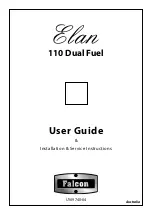
Cooking with the hob
15
© 2021, Elon Group AB. All rights reserved.
COOKING WITH THE HOB
Hob surface
Here is some advice on how to use and maintain the hob surface.
WARNING!
Risk of fire! Overheated fat and oil may ignite. Never leave cooking with fat or oil unattended.
• Make sure the cooking zone and the bottom of the cookware are clean and dry before use to ensure better heat
conduction and prevent damage.
• Do not place wet cookware or lids covered in steam on the cooking zones. Moisture may damage the cooking zones.
• Do not cool down the hot cookware by placing it on the cooking zones that were not in use. The condensed water that
appears under the cookware bottom may aid corrosion.
NOTE!
Prolonged use of the cooking zones may case may discolour the edge of the cooking zone. Such
discolouration does not affect function and is not covered by warranty.
Suitable cookware
For the best results and to prevent damage, make sure you use suitable cookware.
• Use quality cookware with a flat and stable bottom.
• Make sure the cookware bottom fits the diameter of the cooking zone.
When purchasing cookware, note that the indicated diameter usually refers to the upper edge or the
lid, which is normally larger than the diameter of the bottom.
• Cookware made of tempered glass, with a special ground bottom can be used if its diameter fits the cooking zone.
Cookware with larger diameter may crack due to thermal tension.
Turn on and off the cooking zones
1.
Rotate the knob to turn on the cooking zone.
You can set the heating power in steps from 1 to 6.
2.
Turn off the cooking zone by rotating the knob to 0.
Turn off the cooking zone 3 to 5 minutes before the food is ready to make use of the residual heat
and save energy.
NOTE!
Cooking zones indicated with a red dot in the middle are rapid cooking zones. Rapid cooking zones use more
power and can heat up quicker than other cooking zones.
Save energy
Here are some tips on how you can save energy.
• Make sure the cookware bottom fits the diameter of the cooking zone. If the cookware is too small, a part of the heat is
lost and the cooking zone may be damaged.
• Use cookware that fits the amount of food you are cooking. Using larger cookware than required consumes more
energy.
• When possible, cover the cookware with a lid.
• If a dish takes long time to cook, use a pressure cooker.
















































